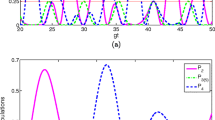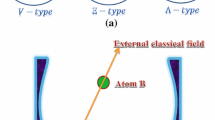Abstract
A scheme is proposed to simulate the Ising model and preserve the maximum entangled states (Bell states) in cavity quantum electrodynamics (QED) driven by a classical field with large detuning. In the strong driving and large-detuning regime, the effective Hamiltonian of the system is the same as the standard Ising model, and the scheme can also make the initial four Bell states of two atoms at the maximum entanglement all the time. So it is a simple memory for the maximal entangled states. The system is insensitive to the cavity decay and the thermal field and more immune to decoherence. These advantages can warrant the experimental feasibility of the current scheme. Furthermore, the genuine four-atom entanglement may be acquired via two Bell states through one-step implementation on four two-level atoms in the strong-driven model, and when two Greenberger-Horne-Zeilinger (GHZ) states are prepared in our scheme, the entangled cluster state may be acquired easily. The success probability for the scheme is 1.
Similar content being viewed by others
References
Bennett C H, DiVincenzo D. Quantum information and computation. Nature, 2000, 404: 247–255
Ding S C, Jin Z. Review on the study of entanglement in quantum computation speedup. Chin Sci Bull, 2007, 52(16): 2161–2166
Ye M Y, Zhang Y S, Guo G C. Quantum entanglement and quantum operation. Sci China Ser G-Phys Mech Astron, 2008, 51(1): 14–21
Qin M, Tao Y J, Hu M L, et al. Entanglement in spin-1 Heisenberg XY chain. Sci China Ser G-Phys Mech Astron, 2008, 51(7): 817–822
Zhang Y, Long G L, Wu Y C, et al. Partial teleportation of entanglement through natural thermal entanglement in two-qubit Heisenberg XXX chain. Commun Theor Phys, 2007, 47(5): 787–790
Zhang J F, Long G L, Zhang W, et al. Simulation of Heisenberg XY-interactions and realization of a perfect state transfer in spin chains using liquid nuclear magnetic resonance. Phys Rev A, 2005, 72(1): 012331-1–8
Chuang I L, Laflamme R, Shor P W, et al. Quantum computers quantum computers, factoring, and decoherence. Science, 1995, 270: 1633–1635
Unruh W G. Maintaining coherence in quantum computers. Phys Rev A, 1995, 51: 992–997
Bennett C H, Brassard G, Crépeau C, et al. Teleporting an unknown quantum state via dual classical and Einstein-Podolsky-Rosen channels. Phys Rev Lett, 1993, 70: 1895–1899
Bennett C H, Wiesner T J. Communication via one- and two-particle operators on Einstein-Podolsky-Rosen states. Phys Rev Lett, 1992, 69: 2881–2884
Ekert A K. Quantum cryptography based on Bell’s theorem. Phys Rev Lett, 1991, 67: 661–331
Bennett C H, Brassard G, Mermin N D. Quantum cryptography without Bell’s theorem. Phys Rev Lett, 1992, 68: 557–559
Deutsch D, Ekert A. Quantum computation. Phys World, 1998, 11: 47–52
Raussendorf R, Briegel H J. A one-way quantum computer. Phys Rev Lett, 2001, 86: 5188–5191
Li W L, Li C F, Guo G C. Probabilistic teleportation and entanglement matching. Phys Rev A, 2000, 61: 034301–034303
Gordon G, Rigolin G. Generalized quantum-state sharing. Phys Rev A, 2006, 73: 062316-1–4
Dziarmaga J. Dynamics of a quantum phase transition: Exact solution of the quantum ising model. Phys Rev Lett, 2005, 95: 245701-1–4
Solano E, Agarwal G S, Walther H. Strong-driving-assisted multipartite entanglement in cavity QED. Phys Rev Lett, 2003, 90: 027903-1–4
Julsgaard B, Sherson J, Cirac J I, et al. Experimental demonstration of quantum memory for light. Nature (London), 2004, 432: 482–486
Julsgaard B, Kozhekin A, Polzik E S. Experimentally long-lived entanglement of two macroscopic objects. Nature (London), 2001, 413: 400–403
Man Z X, Xia Y J. Quantum state sharing of an arbitrary multiqubit state using nonmaximally entangled GHZ states. Eur Phys J D, 2007, 42(2): 333–340
Man Z X, Xia Y J. Genuine multiqubit entanglement and controlled teleportation. Phys Rev A, 2007, 75: 052306-1–5
Yeo Y, Chua W K. Teleportation and dense coding with genuine multipartite entanglement. Phys Rev Lett, 2006, 86: 060502-1–4
Briegel H J, Raussendorf R. Persistent entanglement in arrays of interacting particles. Phys Rev Lett, 2001, 86: 910–913
Duer W, Briegel H J. Stability of macroscopic entanglement under decoherence. Phys Rev Lett, 2004, 92: 180403-1–4
Zou X B, Mathis W. Generating a four-photon polarization-entangled cluster state. Phys Rev A, 2005, 71: 032308-1–4
Tokunaga Y, Yamamoto T, Koashi M, et al. Simple experimental scheme of preparing a four-photon entangled state for the teleportation-based realization of a linear optical controlled-NOT gate. Phys Rev A, 2005, 71: 030301-1–4
Walther P, Resch K J, Rudolph T, et al. Experimental one-way quantum computing. Nature, 2005, 434: 169–176
Eibl M, Kiesel N, Bourennane M, et al. Experimental realization of a three-qubit entangled W state. Phys Rev Lett, 2004, 92: 077901-1–4
Rauschenbeutel A, Nogues G, Osnaghi S, et al. Step-by-step engineered multiparticle entanglement. Science, 2000, 288: 2024–2028
Zheng S B, Guo G C. Efficient scheme for two-atom entanglement and quantum information processing in cavity QED. Phys Rev Lett, 2000, 85: 2392–2395
Osnaghi S, Bertet P, Auffeves A, et al. Coherent control of an atomic collision in a cavity. Phys Rev Lett, 2001, 87: 037902-1–4
Author information
Authors and Affiliations
Corresponding author
Additional information
Supported by the National Natural Science Foundation of China (Grant No. 10774088) and the Key Program of the National Natural Science Foundation of China (Grant No. 10534030)
Rights and permissions
About this article
Cite this article
Zhang, Y., Xia, Y., Man, Z. et al. Simulation of the Ising model, memory for Bell states and generation of four-atom entangled states in cavity QED. Sci. China Ser. G-Phys. Mech. Astron. 52, 700–707 (2009). https://doi.org/10.1007/s11433-009-0099-9
Received:
Accepted:
Published:
Issue Date:
DOI: https://doi.org/10.1007/s11433-009-0099-9




